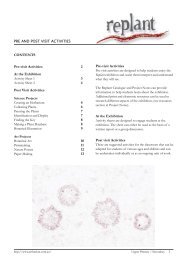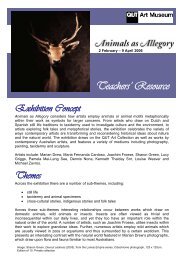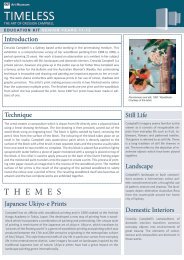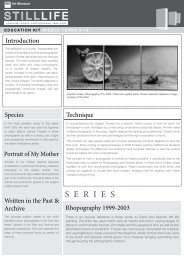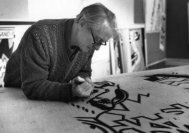Jemima Wyman - QUT Art Museum
Jemima Wyman - QUT Art Museum
Jemima Wyman - QUT Art Museum
Create successful ePaper yourself
Turn your PDF publications into a flip-book with our unique Google optimized e-Paper software.
No Nonsense, Great Shapes: <strong>Jemima</strong> <strong>Wyman</strong><br />
A survey of past and recent video works<br />
EDUCATIONAL RESOURCE<br />
Dazey Girl, 2005, detail digital still. Duration approx 3 mins<br />
About the artist<br />
<strong>Jemima</strong> <strong>Wyman</strong> was born in Sydney in 1977. She undertook her Bachelor of Visual <strong>Art</strong>s at<br />
Queensland University of Technology in 1997 returning and completing with first class honours in<br />
2001. Since the late 90s, <strong>Jemima</strong> has been actively exhibiting paintings, video works,<br />
performance and installations. Bellas Milani Gallery in Brisbane has represented <strong>Jemima</strong> since<br />
2001. In 2005 <strong>Jemima</strong> was one of six Australian artists to receive a Anne & Gordon Samstag<br />
International Visual <strong>Art</strong>s Scholarship. She chose to undertake a two year Master of Fine <strong>Art</strong><br />
Course at the California Institute of the <strong>Art</strong>s, (Cal<strong>Art</strong>s), Los Angeles, America. No Nonsense,<br />
Great Shapes features video works from her practice up to and including works from the first year<br />
of her Cal<strong>Art</strong>s MA.
Samstag award<br />
The Anne and Gordon Samstag International Visual <strong>Art</strong>s Scholarships were established in 1992<br />
through a remarkable bequest by American artist Gordon Samstag, who taught from 1961 to 1970<br />
at the South Australian School of <strong>Art</strong>, now a part of the University of South Australia.<br />
Mr Samstag's substantial Will provided funding to a number of scholarships, annually, to enable<br />
Australian visual artists to "study and develop their artistic capacities, skills and talents outside of<br />
Australia".His unique award was created expressly for the development and education of<br />
Australian visual artists, and is arguably the most prestigious of its kind. Samstag Scholarships -<br />
presented through the South Australian School of <strong>Art</strong> - pay for all the costs of twelve months of<br />
overseas study, including provision of a particularly generous stipend, return airfares and<br />
institutional study fees.<br />
Now in their fourteenth award year, the Samstag Scholarships have become a byword for rapid,<br />
professional success and visibility. In an art world voracious for new stars, the Samstag name is<br />
renowned for identifying artists of exceptional talent and promise. The announcement of a<br />
Samstag Scholarship signals an immediate increase of opportunities and recognition from<br />
dealers, collectors, curators and art magazines alike!<br />
http://www.unisa.edu.au/samstag/<br />
No Nonsense, Great Shapes: <strong>Jemima</strong> <strong>Wyman</strong><br />
No Nonsense, Great Shapes is <strong>Wyman</strong>’s first major solo, video-focused exhibition in Brisbane.<br />
The exhibition employs over 20 screens showing a wide range of video works over the past nine<br />
years. <strong>Wyman</strong>’s work is a visual feast of colour and movement which operates to create a<br />
physiological response in the viewer.<br />
Coloured Suits, 2001, detail digital still, duration 16 mins
Main features<br />
Colour – <strong>Wyman</strong> manipulates scale, saturation and intensity of colour in order to affect the<br />
viewers’ experience of the work. Conventional methods of colour application are aimed at<br />
assisting the viewer’s comprehension of illusionary depth - <strong>Wyman</strong> subverts these methods as a<br />
means of creating a visual experience which causes the viewer to feel the work physically, like a<br />
tremor.<br />
The slide between cognitive and physical experience is an<br />
important element of her practice. As <strong>Jemima</strong> states, ‘if<br />
there was a dominant message that I was trying to<br />
communicate through the work it would be the experience<br />
of encountering the work physically’ 1 .<br />
Catastrophe Theory: Earthquake Girl and Other Stories (Dazey Girl),2005, digital still<br />
The body – <strong>Wyman</strong> views the body as a material to work with. The body in performance is used<br />
just as a painter uses paint - It is flexible and dynamic. <strong>Wyman</strong> exposes this flexibility by creating<br />
characters that are presented as both highly absurd and unnatural. This role playing functions as<br />
a means of critiquing traditional notions of the body as ‘natural’ and our identities fixed. Further<br />
the physical act of simulating a character emphasises our dependence on external signs such as<br />
fashion and skin colour when viewing the body.<br />
Scale and the Viewer/artist relationship – <strong>Wyman</strong> often creates artworks that physically<br />
position the viewer within the work. Shown at the 2005 Primavera exhibition, Scapeology, 2005, is<br />
180x320cm in size. This immense scale, combined with the intensity of the colour immerses the<br />
viewers’ body into a psychedelic landscape. You have entered <strong>Wyman</strong>’s world, thus arriving at a<br />
central theme in her practice; a visceral experience of the work.<br />
Reworking/reuse of works – as you walk through the show you will notice that a number of<br />
works are reused, reinterpreted and re-presented in other works, or that the props from one work<br />
appears in another. This enfolding of one work into another obscures the boundaries between the<br />
individual pieces and encourages the viewer to see the works as part of an encompassing<br />
practice whilst simultaneously challenging the notion of the autonomous original artwork. For<br />
Example in Hula-Hoop Boy and Earthquake Girl, 2005 (below) the backdrop is the painting<br />
Scapeology, 2005 created with enamel based household paint using a pouring. These works do
not remain autonomous, but rather exist in the eclectic, hyperactive realm which <strong>Jemima</strong> creates<br />
for us.<br />
Hula-Hoop Boy and Earthquake Girl, 2005, digital still, duration 12 mins<br />
Process<br />
The playful nature of <strong>Wyman</strong>’s practice is essential to the work. The medium of video creates<br />
another space for this play. In documenting her performances the medium becomes a strategy for<br />
capturing the informal/chance moments which are inherent to live performance. It also enables<br />
<strong>Wyman</strong> to further abstract her constructed performances. <strong>Wyman</strong> uses the editing process to<br />
enhance and manipulate the documented ‘real’ events into surreal or dreamlike ones by colour<br />
enhancement, manipulation of speed or direction and applying filters and effects.<br />
1. http://www.mca.com.au/general/<strong>Jemima</strong>_<strong>Wyman</strong>.pdf<br />
Video <strong>Art</strong><br />
Video art emerged during the 1960s and 1970s and is comprised of video and/or audio data.<br />
Traditionally video art was (and sometimes still is) recorded on video tapes. In recent years the<br />
shift from analogue to digital technologies has changed video into electronic formats. Video art is<br />
screened in many ways - it can be projected onto walls or displayed on television and computer<br />
screens in numerous locations.<br />
It is important not to mistake video art for film. Video art does not rely on conventions that define<br />
film such as employing actors, dialogue, narratives and plots. Compared to film, video is cheap,<br />
accessible, immediate and modern. These factors play a vital part in portraying artistic intentions.<br />
Video artists do not consider their art as a form of entertainment; rather they often consider their<br />
work to be art videos or activist driven documentaries. Many artists explore the boundaries of<br />
video as a medium and aim to subvert viewer’s expectations of conventional cinema.
It is now common for many contemporary artists to combine video art with other media, within<br />
installation or performance art for example, or as a documentary aspect of artistic practice.<br />
Performance <strong>Art</strong><br />
Performance art is a form which the actions of an individual or a group at a particular place and in<br />
a particular time constitute the work. It can happen anywhere, at any time, or for any length of<br />
time. Performance art can be any situation that involves four basic elements: time, space, the<br />
performer's body and a relationship between performer and audience. It is opposed to painting or<br />
sculpture, for example, where the object, not the action constitutes the work.<br />
Although performance art could be said to include relatively mainstream activities such as theatre,<br />
dance, music, and circus-related things like fire breathing, juggling, and gymnastics, these are<br />
normally instead known as the performing arts. Performance art is a term usually reserved to refer<br />
to a kind of usually avant-garde or conceptual art which grew out of the visual arts.<br />
Performance art, as the term is usually understood, began to be identified in the 1960s with the<br />
work of artists such as Vito Acconci, Hermann Nitsch, Joseph Beuys, and Allan Kaprow, who<br />
coined the term Happenings. Happenings were a performance, event or situation, meant to be<br />
considered as art, taking place anywhere, and were often multi-disciplinary, lacked a narrative and<br />
frequently sought to involve the audience in some way. Western cultural theorists often trace<br />
performance art activity back to the beginning of the 20th century. Dada for example, provided a<br />
significant progenitor with the unconventional performances of poetry by Richard Huelsenbeck<br />
and Tristan Tzara. There are also accounts of Renaissance artists putting on public performances<br />
that could be said to be early ancestors to modern performance art. Some performance artists<br />
point to other traditions, ranging from tribal ritual to sporting events. It is important to note that<br />
Performance art is not confined to Euro-american art worlds.<br />
http://en.wikipedia.org/wiki/Performance_art<br />
Performance in Video<br />
During the 1960s, video became a more viable medium and many artists began to use video to<br />
record performance. Within this new media performance could be transformed in a multitude of<br />
ways. Within video the performance becomes abstracted and moves into a relationship with mass<br />
media.
Video and Performance in the video framework, grew from the social and sexual revolutions of the<br />
1960s-70s. As television became the dominant medium, an increasing awareness and critique of<br />
television’s imagery and the perpetuation of stereotypes (such as gender and racial ) developed<br />
in a number of artists’ work. Joan Jonas, Hannah Wilke, Lynda Benglis and Dara Birnbaum<br />
worked with the body to address these issues. Their works aimed to fragment the body and<br />
subvert notions of authentic womanhood. It could be said that <strong>Wyman</strong> also treads a similar path;<br />
the body in <strong>Wyman</strong>’s works is rendered as a changeable object, capable of representing multiple<br />
identities and therefore readings of the female body. An element that links these art practices is an<br />
implied mocking of conventional stereotypes that appear daily on our television screens.<br />
Vulva Girl, 2003, digital video, Lightweight Poncho, 2000, digital video, Turning Turning, 2001, digital video<br />
duration 16 mins duration 36 mins duration 12 mins<br />
Influences<br />
‘Yayoi Kusama, would probably be one of the most consistently influential artists on my<br />
practice...this is for a multitude of reasons but primarily because she loves "infinity" and doesn’t<br />
limit her approaches to making, viva "infinity"’ - <strong>Jemima</strong> <strong>Wyman</strong> 4<br />
Yayio Kusama<br />
Left: Kusama self-obliteration by dots, 1968, performance documentation photography by Hal Reif. Right: Kusama mirror room,<br />
1991, mirrors, wood, paper mache, paint, 200x200x200cm, collection Hara <strong>Museum</strong>, Tokyo
Yayoi Kusama, (born 1929) has been called Japan's greatest living artist. Born in Matsumoto,<br />
Nagano Prefecture, Kusama has experienced hallucinations and severe obsessive thoughts since<br />
childhood, often of a suicidal nature.<br />
Early in Kusama's career, she began covering surfaces (walls, floors, canvases, and later,<br />
household objects and naked assistants) with the polka dots that would become a trademark of<br />
her work. The vast fields of polka dots, or "infinity nets", as she called them, were taken directly<br />
from her hallucinations.<br />
She left her native country at the age of 27 for New York City, on the advice of Georgia O'Keefe.<br />
During her time in the United States, she quickly established her reputation as a leader in the<br />
avant-garde movement. She organized outlandish happenings in conspicuous spots like Central<br />
Park and the Brookyln Bridge, was enormously productive, and counted Joseph Cornell among<br />
her friends and supporters. Although Kusama exhibition with influential artists in New York, she<br />
never achieved long term critical or financial success and returned to Tokyo in the mid-seventies.<br />
Her work shares some attributes of feminism, minimalism, surrealism, art brut, pop, and abstract<br />
expressionism, but she describes herself as an obsessive artist. Her artwork is infused with<br />
autobiographical, psychological, and sexual content, and includes paintings, soft sculptures,<br />
performance art, artist books, photo collages and installations.<br />
Yayoi Kusama has exhibited work with Claes Oldenburg, Andy Warhol, and Jasper Johns. In 1993<br />
Kusama represented Japan at the Venice Biennale and a major retrospective exhibition of her<br />
work toured the U.S. and Japan in 1998 & 1999. Today she lives, by choice, in a mental hospital<br />
in Tokyo, where she has continued to produce work since the mid-seventies. Her studio is a short<br />
distance from the hospital. Kusama is often quoted as saying "If it were not for art, I would have<br />
killed myself a long time ago".<br />
http://www.oneroom.org/sculptors/kusama.html<br />
For further information of the artist visit her website:<br />
www.jemimawyman.net


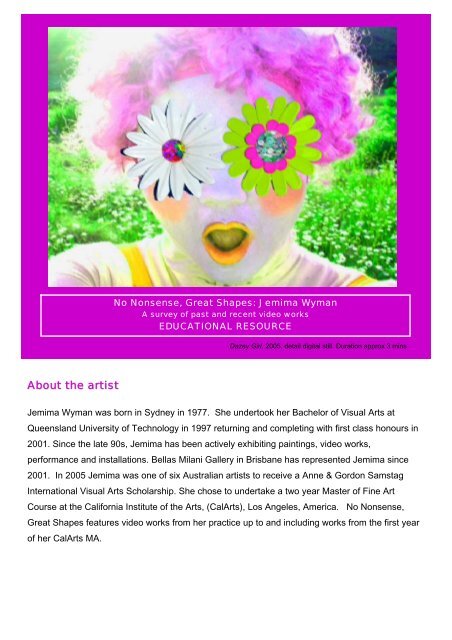

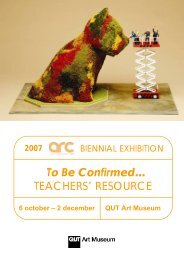

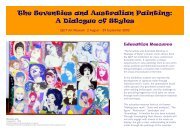
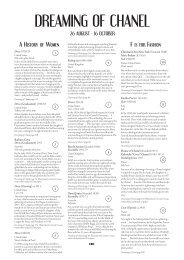
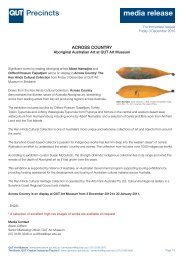
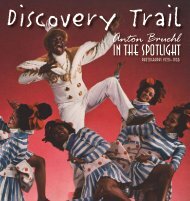

![Senior Years (10-12) [pdf - 4.5 MB] - QUT Art Museum](https://img.yumpu.com/38225334/1/184x260/senior-years-10-12-pdf-45-mb-qut-art-museum.jpg?quality=85)
